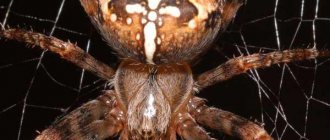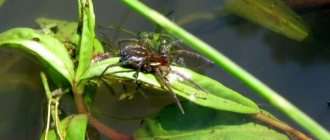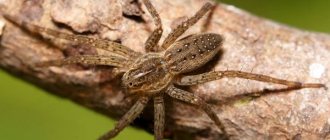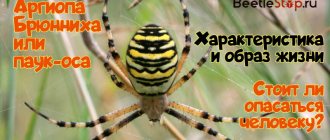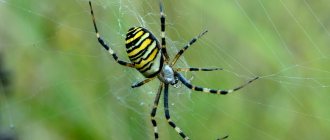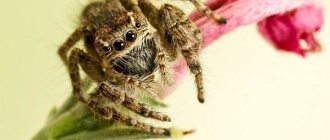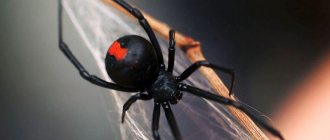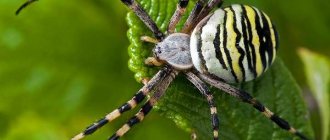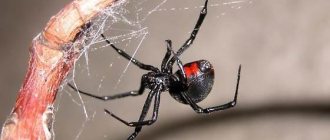The cross spider is a representative of the suborder of araneomorphic spiders of the orb-weaver family. There are more than 600 species of these arthropods in the world. The distribution area of the crusaders is quite extensive - they can be found on almost all continents except Antarctica. About 30 species of these arachnids live in our latitudes.
Spiders of this genus represent a striking case of sexual dimorphism. In addition to differences in the genitals, two heterosexual crosses differ in size, color, habits and other characteristics. After reading this article to the end, readers will become familiar with many interesting details from the life of these tiny creatures, and will also find out how dangerous a spider bite is for humans.
Origin of the species and description
Photo: Cross spider
Cross spiders are representatives of the order of spiders, suborder of araneomorphic spiders, family Araneidae, genus of cross spiders.
To date, scientists can only approximately indicate the period of appearance of ancient arthropods. The chitinous shell of these representatives of flora and fauna disintegrates quite quickly, leaving virtually no traces. A few remains of ancient arthropods were discovered in pieces of frozen resin, or in amber. Today, zoologists call the approximate period of the appearance of arachnids - 200-230 million years ago. The first spiders had very small body sizes, which did not exceed half a centimeter.
Video: Cross spider
Their body structure was also significantly different from modern ones. Spiders of that time had a tail, which was intended for making strong web threads. The so-called web was used to line their burrows, or shelters, and also to protect the clutch of eggs from damage and extinction. During the process of evolution, the tail part of ancient arthropods disappeared. However, the modern spinning machine they have now did not appear immediately.
The first spiders supposedly appeared on Gondwana. Then they very quickly spread across almost the entire landmass. Subsequent ice ages significantly narrowed the regions of their residence. Arthropods are characterized by a fairly rapid evolution, during which spiders changed in appearance depending on the region they lived in, as well as on belonging to a particular species.
Is the crusader spider dangerous for humans?
The spider's venom is toxic enough to immobilize a potential victim. For various types of insects, as well as invertebrates, the venom of the crusader spider is fatal, but animals such as sheep, horses, dogs, and guinea pigs are quite resistant to the venom of the crusader spider. Only a short-term deterioration in health is possible.
This spider does not pose a danger to humans; moreover, when it sees a person, it tries to hide in a nearby shelter. But if you try to catch it, it may bite, after which 2 small spots appear on the body. Pain and burning may appear immediately, and the next day the wound may fester. People with weakened immune systems, as well as children, may experience a deterioration in their overall health after being bitten. The result is general weakness, nausea, headache, dizziness, and abdominal discomfort. After a few days, the victim’s condition returns to normal.
Cross spider and interesting facts about it
Appearance and features
Photo: Large cross spider
Like other representatives of arachnids, the body of the cross is divided into two segments: the cephalothorax and abdomen. In addition, they have arachnoid warts and a walking apparatus, the latter being represented by the femur, knee joint, tibia, forearms, tarsi and claw. Spiders also have chelicerae and pedipalps.
Crosses have fairly small body sizes. Representatives of this species have pronounced sexual dimorphism - males are significantly inferior to females in body size. The average body length of a female individual is 2.0-4.5 cm, and that of a male individual is 1.0-1.2 cm.
The body of the arthropod is covered with a sand-colored chitinous shell, which insects typically shed during the molting period.
Spiders have 12 limbs:
- one pair of chelicerae, the main purpose of which is to fix and kill caught prey. This pair of legs points downwards;
- four pairs of walking limbs that have claws at the tips;
- one pair of pedipalps, which are designed for fixing their prey. It is noteworthy that on the last segment of these limbs in males there is a reservoir into which seminal fluid enters, which is subsequently transferred to the spermatheca of the female.
Crosses have as many as four pairs of eyes, but they are poorly developed. The vision of these representatives of arthropods is poorly developed; they can only distinguish silhouettes and general outlines. The reference point in the surrounding space is the sense of touch. This function is performed by hairs that cover almost the entire body.
Interesting fact: Spiders have a huge variety of hairs of different types on their bodies. Each type is responsible for receiving certain types of information: light, sound, movement, etc.
The abdomen of the cross has a round shape. It is missing any segments. On the upper surface there is a clearly defined pattern in the form of a cross. In its lower part there are three pairs of special arachnoid warts. It is into these warts that thousands of glands open, which produce strong, reliable arachnoid threads.
The respiratory system is located in the abdomen and is represented by two pulmonary sacs and a tracheal tube. The heart is located in the back area. It has the shape of a tube and vessels branching from it.
Classification and habitat
The crusader spider belongs to the orb weaver family. Protostomes are more common in temperate latitudes. Habitat: dry land. Arthropods are found on all continents, with a greater distribution in North and South America.
The classification of representatives of the infraorder Arneomorphae began in 1805. Its founder was Charles Walkener. Currently, about 650 species are known.
Where does the cross spider live?
Photo: Cross spider in Russia
Spiders of this species are characterized by a ubiquitous distribution. They live in almost every country in Eurasia. Also quite common in North America.
Crosses prefer areas with high humidity, little sunlight and high air temperatures. Spiders love to mingle on the edges of forests, meadows, gardens, and fields. Human housing is no exception. Once in living spaces, spiders climb into crevices or joints between walls, inaccessible places, spaces between furniture and walls, etc. Crossworts can often be found on various types of vegetation located near a body of water.
Geographical regions:
- territory of almost all of Europe;
- Russia;
- Africa;
- Asian countries;
- North America.
Spiders prefer to settle in places where it is easy and convenient to weave their fishing nets, which are likely to catch a sufficient number of insects. In Russia, crosses are often found in city parks and squares.
Now you know where the cross spider lives. Let's see what he eats.
Lifestyle
The natural habitats of crusader spiders are their natural environment, but they can often be found in human homes. They show their main activity at night, and during the day they prefer to hide in their shelters. Therefore, the spider weaves its web at night. Being in the natural environment, the spider builds itself a house from leaves, and weaves a web in the spaces between the trees.
The web of the cross is a rather complex engineering structure, consisting of 39 radii of various sizes, 35 spiral turns, as well as 1245 points of contact of the threads. As mentioned above, some species can weave webs up to 2 meters in diameter.
Interesting fact! The spider weaves a web at night, and during the day it works, that is, the victim gets caught in it. If the web is damaged, the spider repairs it or weaves a new one. The diet of birds also includes spiders, but at night the birds rest, so the spiders go out hunting.
Experts say that spiders can live for about 2 years, although in the natural environment rarely do any spiders manage to live even 2 years due to the presence of natural enemies. In home conditions close to natural conditions, the spider can easily live up to 2 years.
What does the cross spider eat?
Photo: Cross spider in nature
The cross is far from a harmless representative of arthropods. It belongs to the poisonous species of arachnids, and by nature is considered a hunter. It goes hunting most often at night.
What is the food source:
- flies;
- mosquitoes;
- butterflies;
- vile;
- aphid.
When going hunting, the cross is located in the central part of the web and freezes. If you observe him during this period of time, he appears to be dead. However, if the prey gets caught in the net, the spider plunges its front pair of limbs into it with lightning speed, injecting poison. After a short period of time, the potential food stops resisting. Crossbills can eat it right away or leave it for later.
These representatives of arachnids are considered voracious. To be satisfied, they need an amount of food per day that exceeds their own body weight. For this reason, spiders spend most of the day hunting. They rest mostly during the day. Even during the rest period, the signal thread is always tied to one of the limbs of the cross.
Interesting fact: The cross spider does not eat everyone who falls into its trapping nets. If a poisonous insect, or one that emits an unpleasant odor, or a huge insect gets caught in them, the spider simply bites through the fixing threads and lets it go.
Arthropods have an external type of digestive tract. They cannot digest food on their own. They tend to partially digest it with the help of injected poison. Only after the insides of the caught insect turn into a liquid substance under the influence of the toxin do the spiders drink it. Also, spiders often, after paralyzing the victim, wrap it in a cocoon of their web. The process of partial digestion also occurs in it.
Nutrition
The living creatures described are carnivorous. In addition to the flies and mosquitoes already mentioned, aphids, various midges and other small representatives of the insect world can become their prey. If such a prey falls into the net of a given predator, then he has the opportunity to feast on it immediately.
But, if he is full, he is able to leave food for later, entangled with a thin adhesive thread. By the way, the composition of such a “rope” is somewhat different than the thread of a spider’s web. Further, the spider hides its food supply in any secluded place, for example, in the foliage. And he eats it when he feels hungry again.
These spiders have a very excellent appetite. And their bodies require a lot of food. The daily norm is so high that it is approximately equal to their own weight. Such needs force the described representatives of the animal world to work accordingly.
Cross hunters, lying in wait for prey, sit in ambush with virtually no rest, but even if they are distracted from business, it is for a very short time.
These creatures digest their food in an extremely interesting way. This happens not inside the body, but outside. The spider simply releases a portion of digestive juice into the body of the victim, wrapped in a cocoon. In this way it is processed, turning into a substance suitable for consumption. Next, this nutrient solution is simply drunk by the spider.
It happens that the nets placed by these eight-legged creatures catch prey that is too large for such a baby to handle. The spider tries to get rid of such problems by deliberately cutting off the threads of the network connecting itself.
But if the threat does not stop there, for the purpose of self-defense he is quite capable of successfully using his chelicerae against what are, from his point of view, huge creatures. For example, a frog a quarter of an hour after its bite may be completely immobilized.
But are cross spiders dangerous for humans or not ? Actually, the poison of these creatures does not produce irreversible changes on the body of all vertebrates. On people, due to the small amount of toxic substances produced by these arachnids compared to human size, they are not able to have a serious effect. The bitten subject feels only mild pain, which subsides fairly quickly.
Features of character and lifestyle
Photo: Common cross spider
Spiders are nocturnal arthropods, which tend to be most active at night. They spend most of their time hunting and have little rest. As habitats, be sure to choose places where there is a lot of moisture and little sunlight.
Webs are often woven between the branches of bushes, trees, various types of vegetation, blades of grass, etc. They themselves settle down in a secluded place near their fishing net. The web threads that crosses can weave have great strength and are capable of holding even fairly large insects, whose dimensions are several times larger than the size of the body of the spider itself.
Crossers are considered real hard workers, as they tirelessly weave their web. They tend to weave huge webs. Once they become unsuitable for catching prey, they scatter it and weave new nets.
Interesting fact: The spider will never get entangled in its own trapping nets, since it always moves strictly along a certain trajectory of non-sticky areas.
Spiders also weave webs mainly at night. This is due to the fact that the main enemies of crosses are diurnal and hunt them during daylight hours. In the process of forming a trapping network, spiders show accuracy, detail and scrupulousness. In the process of their life, they rely not on vision, but on touch. Krestovik lead an exclusively solitary lifestyle.
Interesting Facts
A spider with a cross has the following features:
- The web of the cross is of great interest. It is elastic and has high strength. Since ancient times it has been used to make fabrics or decorations. People from tropical countries weave nets and nets from it to catch fish.
- Microbiologists have also not ignored the spider web. They use it to determine the composition of atmospheric air, as well as to produce the thinnest optical fiber.
- Interestingly, spiders move freely through their trapping webs and do not stick to them. This is explained by the fact that they move along radial, dry threads.
Crossmen are unique creatures. They can be very useful for a person. But if, due to an unfortunate combination of circumstances, the arthropod still bites, then first aid measures should be taken. But there is no reason to seriously fear for your health after this.
Social structure and reproduction
Photo: Cross spider
Throughout the spring and summer, males are busy forming webs and ensuring a sufficient amount of food. During the mating season, males leave their shelters and begin to actively look for a female to mate with. During this period, they eat practically nothing, which explains such a significant difference between male and female individuals.
Crossworts are dioecious arthropods. The period of mating relations and courtship of females often occurs at night. It consists of males performing peculiar dances that involve tapping their limbs. After the male manages to reach the head of the female with his limbs, the transfer of seminal fluid occurs. After mating, most males die from the poisonous secretion of the female.
The period of marriage occurs at the end of the summer season, the beginning of autumn. The female makes a cocoon from the web in which she places her eggs. One cocoon can contain from 3 to 7 hundred honey-colored eggs. At first, the female wears this cocoon on herself, then finds a secluded place and hides it. The cocoon reliably hides future offspring from rain, wind and cold. In the spring, spiderlings begin to emerge from the eggs. They stay inside the cocoon for a short period of time, then come out of it and crawl away in different directions. Little crosses immediately become independent and lead an isolated lifestyle.
After the spiderlings leave the cocoon, they try to separate as quickly as possible. Due to high competition and the possibility of becoming food for older individuals, such a step will significantly increase the chance of survival.
Interesting fact: Due to the fact that newly born young individuals have rather small and weak limbs, in order to separate from each other they use a web, on which they can fly up to several hundred kilometers, provided there is wind.
Crosses adapt well to new conditions. It is because of this that lovers of exotic flora and fauna often keep them as pets. To maintain them, a terrarium of sufficient size is used to provide space for a fairly large web.
I
The venom of the cross spider is not dangerous to humans, but at the site of the bite one feels burning pain, hemorrhages in the subcutaneous tissue, headaches, weakness, sometimes colic and joint pain. Tissue necrosis may develop at the site of the bite. Treatment is symptomatic. Females bite more often than males.
The venom of the cross spider is toxic only to invertebrates and vertebrates. The poison contains heat-labile hemolysin, which acts on the red blood cells of rabbits, rats, mice, and humans, while the red blood cells of guinea pigs, horses, sheep and dogs are resistant to it.
Literature: 1. Invertebrate animals. Study them at school. V.P. Gerasimov. Moscow, 1978 2. Plants and animals. K. Nidon, Dr. I. Peterman, P. Scheffel, B. Shaiba Translation from German by N.V. Khmelevskaya, Moscow “Mir”, 1991 3. B. N. Orlov, D. B. Gelashvili, A. K Ibragimov. Poisonous animals and plants of the USSR. Moscow “Higher School”, 1990, etc.
Natural enemies of cross spiders
Photo: Female cross spider
Despite the fact that the crusader is classified as a dangerous, poisonous spider, it also has enemies. It is in order to reduce the likelihood of being eaten that they are most active at night. The main enemies of this type of arthropod can be called birds, as well as insects - parasites. Some species and flies wait until the spider freezes on its web in anticipation of its next victim, fly up to it and instantly lay eggs on its body.
Subsequently, parasitic larvae emerge from them, which, in fact, feed on the insides of the spider. When the number of parasites increases, they practically eat the spider alive. Crusaders are small in size, which often leads to them themselves becoming prey to other, larger arachnids. Some amphibians, such as lizards or toads, can also be considered enemies of the crusaders.
The main enemies of the cross spider in natural conditions:
- salamanders;
- geckos;
- iguanas;
- frogs;
- hedgehogs;
- the bats;
- ants.
Man is not the spider's enemy. Rather, crusaders in some cases can cause harm to human health. It is unusual for them to attack first. When meeting a person, these representatives of arthropods rush to hide. However, if they sense danger, they attack. A healthy adult will not die as a result of a bite, however, they will definitely feel discomfort and a change in their general well-being.
The consequence of a cross bite is pain, dizziness, nausea, vomiting, swelling, and suppuration of the bite site. Most often, all of the above symptoms disappear without drug treatment.
What to do if you are bitten
The spider bite is not fatal to humans, cattle, horses, dogs, sheep, the danger exists only for rats, rabbits and mice.
Usually, the spider bites a person by accident if he falls into a web where a hunter is waiting for his prey. Its poison is a colorless, cloudy and viscous liquid.
Preventing a Bite
To avoid a spider bite, you should follow some simple recommendations:
- When going to bed in nature, be sure to close the entrance to the tent at night;
- Before going to bed, carefully examine your bed, clothes and shoes;
- be careful near the webs, remember that there is a cross nearby that is waiting for the victim;
- be careful during country and garden work;
- be vigilant when in abandoned old premises;
- If you find a cross, do not try to pick it up.
Symptoms
The cross spider is able to bite through only the thinnest skin. In terms of pain, the bite is comparable to a bee sting; a person feels the prick of a thin needle, and sometimes does not notice anything at all.
A white spot with red or pink edges, small in size (no larger than a five-kopeck coin), appears at the site of the lesion.
The main signs of a spider bite that develop after 5-20 minutes include:
- irritation at the site of injury;
- aching joints;
- weakness;
- skin redness;
- slight chills;
- subcutaneous hemorrhages;
- slight increase in temperature;
- edema;
- hardening of the skin;
- headache;
- burning.
First actions after a bite
If you are bitten by a cross, the following actions should be taken:
- wash the affected area with running water and soap to eliminate the risk of infection;
- Apply ice or a cold compress to the bite site;
- if you have a fever or headache, it is recommended to take paracetamol;
- If you have an allergic reaction, take any antihistamine that does not require a prescription.
If there is a rapid increase in symptoms or a child has been bitten, it is recommended to seek help from a doctor.
The wolf spider does not weave a web to get food for itself - it catches up and paralyzes the victim. The black imperial scorpion is one of the largest species of animals in this class. You will find a detailed description here.
Scolia wasps are very caring parents. For information about the reproduction characteristics of these wasps, read the article at the link.
The use of cobwebs in agriculture and medicine
People have long tried to make fabric based on spider webs. In Germany, back in the 16th century, ribbons and various decorations were woven from cobwebs in villages. Then in France, artisans came up with the idea of making gloves and stockings from spider webs, which caused complete delight among fashionistas.
But it turned out to be impossible to launch this technology into large-scale production, and this was convincingly proven by the physicist and zoologist Reaumur. For such production to become profitable, it is necessary to contain and feed hundreds of thousands of spiders. But to feed them, it would be necessary to catch several million flies every day, which was completely impossible to implement in practice.
However, people still use the web, even today. For sights (crosshairs) in various optical instruments (microscopes, telescopes, sights, etc.), spider webs are simply ideal. Microbiologists have also found use for it, developing a unique air analyzer using it.
The cross spider is launched onto a special frame, fed, and the spider weaves its web based on this frame. Then air is pumped through a frame with a net, and the thinnest web perfectly captures the microbes that are in the air. This method of air analysis has been recognized as the most effective of all existing in the world.
In folk medicine, spider webs have been used since ancient times to disinfect open wounds. Research has confirmed that spider webs kill pathogenic bacteria, and with its help, drugs have been developed that are harmless to animals, but deadly to all kinds of bacteria. As you can see, the cross spider is extremely useful for humans, in every sense.
Varieties of Crusader Spiders
Arachnalogy includes more than 650 species of representatives of the genus Arneomorpha, a family of orbweavers. About 30 species are found on the territory of Russia and the Commonwealth countries. All of them are characterized by the presence of markings in the form of a cross on the upper part of the abdomen.
Crusaders are important to nature. Arachnids are natural regulators of the number of insects, mainly flies and mosquitoes. Some representatives are listed in the Red Book (angular cross).
The most common crosses in Russia:
- Araneus diadematus (common cross)
- Araneus quadratus (four-spotted or meadow);
- Araneus ceropegius (oak);
- Steatoda bipunctata (networt);
- Araneus sturmi (orb weaver);
- the cross is chilly.
Common cross
This species has several names: European garden, tiara, orange, crowned weaver's ball. Color varies from rich light yellow to dark gray. On the dorsal part of the abdomen there are spotted white markings with four or more segments forming a cross. The stains are formed by guanine, which is a byproduct of protein breakdown.
The common cross is medium in size. Adult females reach a length of 6.5-20 mm, males are slightly smaller - 5.5-13 mm. The cephalothorax is covered with chitin, serving as a strong shield, and eight simple eyes are located on its front part. The body is covered with a substance that contains components that prevent moisture evaporation.
Angular cross
Araneus angulatus lives throughout Europe and Asia (except for the Arabian Peninsula). It was first described in 1757. Color varies from light yellow to gray. There are spots on the back - white marks.
Females grow up to 2 cm in length, males - no more than 1.3. Large females build the nets and hang on them upside down, waiting for prey. The spider quickly bites the victim caught in the web and wraps it in thread.
Representatives of the species can devour each other after mating.
Araneus albotriangulus
The white-winged weaver spider is a member of the orb-weaver family, formerly known as Araneus parvulus. It is small, the body length of the female is about 4 mm, the male is 2 mm. The description compares it to a fluffy egg sac. The opisthosoma has two symmetrical yellow markings in the shape of wings or triangles. Hence the species name – albotriangulus. It has 4 front legs hidden under the cephalothorax, and the hind legs are located along the stomach.
The animal has 8 eyes of the same size, arranged in 2 rows. The front eyes are dark, the rest are lighter.
The crossbill lives in Australia, mainly in New South Wales and the north-eastern state of Queensland. It weaves a loose, tangled web in dense bushes (Bush currant), foliage of trees, and on the walls of buildings. The anterior arachnoid warts are located far from each other. The oral appendages of males are powerful, often elongated. The male uses vertical chelicerae to hold the female during mating.
They mate in late spring or early summer. Interesting fact: males die after fertilizing a female. The female places eggs (on average 7-35 pieces) in a white lens cocoon. There may be several storage areas for larvae; they are disguised by small particles of foliage and bark.
Araneus albotriangulus is only dangerous to flies and leafhoppers.
Barn spider
The main habitat of the obligate predator is North America and the adjacent territories of Canada. In the southwest it is found all the way to the border with Mexico.
Areneus cavaticus got its name because it weaves traps for prey in shaded places - in barns (pits, depressions), overhanging rocks, caves. It is found near human houses, in village buildings, where artificial lighting attracts flying insects.
Males and females look the same. The abdomen is pale or yellow, with dark brown edges. On the reverse side of the opisthosoma there are two white markings on a black background. The limbs are covered with ash-gray hairs. They are dark brown in color with yellow-brown stripes.
The arthropod is active at night. During the day it hides in rolled up leaves; at night it waits for prey, sitting in the center of a trap it has woven. Barn spiders have a peculiarity - for a new web, they take threads from previous ones, saving their resources.
Some representatives have a poisonous bite, but not to humans. The substance released is toxic to victims. Arthropods are aggressive towards each other. When excited, they jump up and down in an attempt to look more threatening.
Cat-faced spider
Gemmoides Araneus is a beneficial natural predator. Females reach a length of 1.3-2.5 cm, males - 5.4-8 mm. The body is covered with fleece of different colors - from dark to light. But all of them have a horn-like growth with black spots, which looks like a cat’s face.
The habitat of the arthropod is the USA and Canada. It can be found under canopies, trees, and in animal burrows. The web has a typical concentric design with spiraling sticky coils. Gemmoides Araneus processes damaged nets into new ones and places them in places with the greatest concentration of insects. The entangled arachnid fly is paralyzed by saliva produced by the digestive glands.
Mating occurs at the end of summer. The female crosstail dies a few days after laying one sac containing hundreds of eggs. The cocoons can survive the winter, and the emerging spiders eat their brothers and sisters. The organs of young animals are poorly developed. Immature arachnids are mixed with the help of air currents, wrapped in strands of a cocoon.
Araneus mitificus
Black spiders with a characteristic white cross on their back are found in South and Southeast Asia, the Philippines, and Australia. Representatives of small sizes with sexual demorphism. Females grow up to 6-9 cm, males reach a length of 3-5 mm and, as a rule, are more colorful than the female half.
The cephalothorax is red, yellowish or green. The sternum is heart-shaped, tapered towards the back. Covered with black hairs. It has 8 eyes arranged in two curved rows. The central rear eyes are surrounded by a dark ring, the lateral ones are located close to each other.
The lip is wide, the maxillary oral organs are square in shape. Tufts of sensitive hairs are observed at the tips. The oral appendages (chelicerae) are yellowish or brown in color.
The legs are strong and long - from reddish to brown. The distal ends of the leg segments have transverse stripes of a dark brown hue. They are covered with long spines and fine hairs.
They live in places with low vegetation. The victim becomes entangled in the web and vibrates, this is transmitted to the signal thread, the spider receives “information” about the prey it has encountered and goes to it.
Oak spider
This type of cross is popularly called Epeira des bois, which means “spiny legs” or “sharp belly at the end.” Males are small - up to 7 mm, females are much larger - 15-17 mm. The front of the belly has a distinctive oak leaf design (hence the name).
The habitat is quite extensive. It lives in low bushes (especially brooms), in meadows, roadsides, and gardens. Found in the mountains, up to 3000 m above sea level.
The web serves not only as a net for prey, but also as a shelter from the weather. When danger approaches, the arthropod is thrown out of its web, remaining attached to the thread.
Reproduction occurs in autumn. The female leaves cocoons for the winter in cracks in the bark of trees.
Meadow cross
The four-spotted crusader lives in Europe, Japan, and Central Asia. Prefers to live in open areas with thick, wet grass (meadow). They also live in gardens, wooded areas and where they can stretch webs and catch food. They place their nets close to the ground to catch jumping insects such as small grasshoppers.
The dimensions are similar to an ordinary cross. The color is varied - from light yellow to black-brown. On the upper part of the opithosoma there are 4 light spots and 4 black dots. The legs are brightly striped.
Females reach 1.7 cm in length, males - no more than 10 mm. Females may change color slightly when in danger.
Araneus quadratus matures in one season. They mate in late summer or September. The cocoon overwinters, and the young emerge in the spring. Developmental features make the spider very voracious; it does not disdain any insects. Studies have revealed that a representative eats up to 1 mg per day for every milligram of his own weight.
Internal structure
Digestive system
The spider's digestive system consists of the mouth, pharynx, esophagus, stomach, and intestines (front, middle and back). In the midgut, long blind processes increase its volume and absorption surface.
Undigested residues are expelled through the anus. The spider cannot eat solid food. Having caught prey (some insect) with the help of a web, he kills it with poison and lets digestive juices into his body. Under their influence, the contents of the captured insect liquefy, and the spider sucks it up. All that remains of the victim is an empty chitinous shell. This method of digestion is called extraintestinal.
Circulatory system
The spider's circulatory system is not closed. The heart looks like a long tube located on the dorsal side of the abdomen.
Blood vessels extend from the heart.
In a spider, the body cavity is of a mixed nature - during development it arises from the connection of the primary and secondary body cavities. Hemolymph circulates in the body.
Respiratory system
The spider's respiratory organs are the lungs and trachea. The lungs, or pulmonary sacs, are located below, in the front of the abdomen. These lungs developed from the gills of the distant ancestors of spiders that lived in water.
The cross spider has two pairs of non-branching tracheas - long tubes that deliver oxygen to organs and tissues. They are located in the back of the abdomen.
Nervous system
The spider's nervous system consists of the cephalothoracic nerve ganglion and numerous nerves extending from it.
Excretory system
The excretory system is represented by two long tubes - Malpighian vessels. One end of the Malpighian vessels ends blindly in the body of the spider, the other opens into the hind intestine. Harmful waste products come out through the walls of the Malpighian vessels, which are then excreted. Water is absorbed in the intestines. In this way, spiders conserve water so they can live in dry places.
